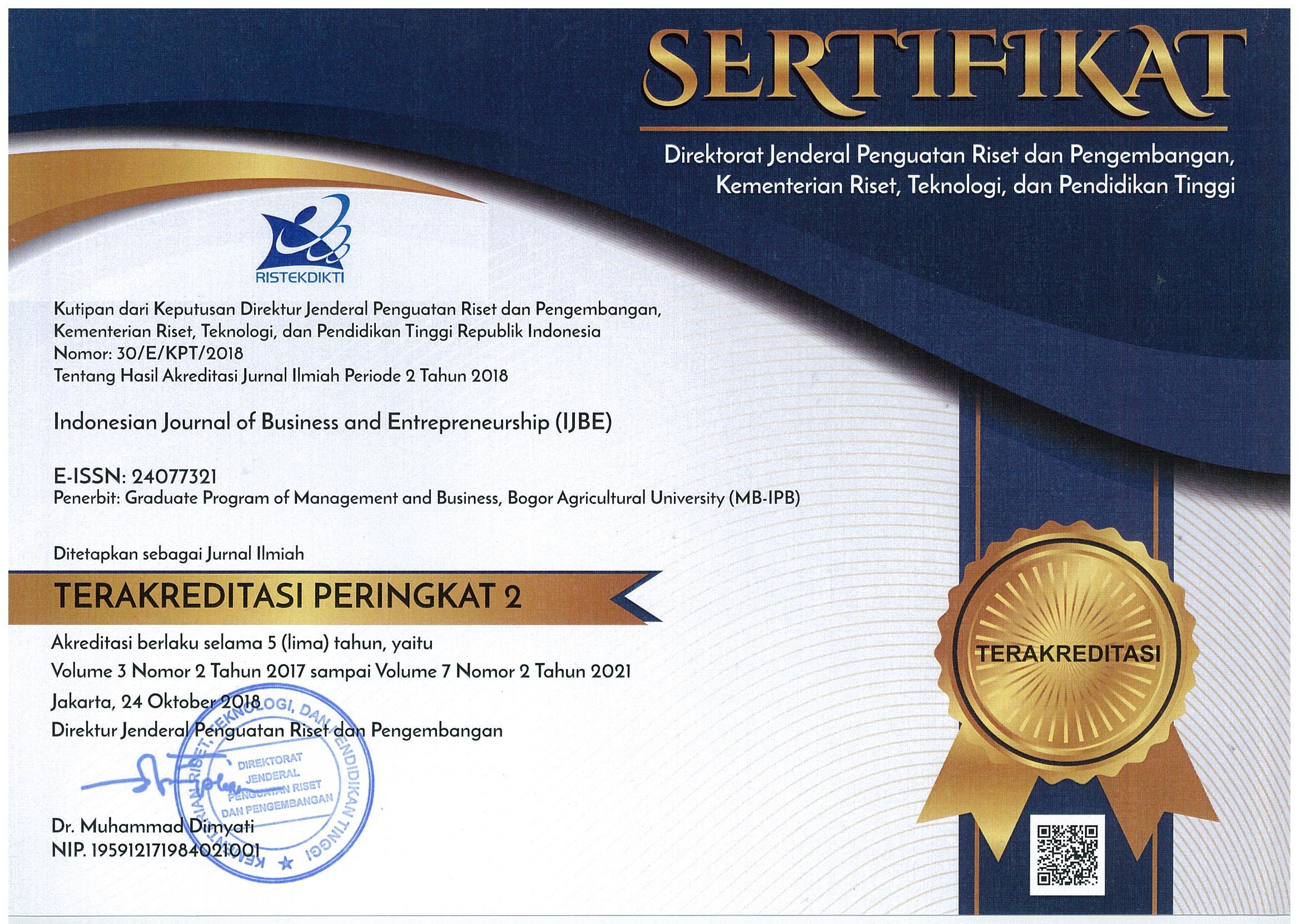LEADING SECTOR DEVELOPMENT AND IT'S IMPLICATONS ON THE LENDING PORTFOLIO AND NON-PERFORMING LOAN OF SMALL MEDIUM ENTERPRISES
Abstract
The research objectives were to analyze the condition of the SMEs lending portfolio and a comprehensive strategy to ensure that the SMEs Line of Business could grow sustainably. There are several analytical methods employed in this study, such as Location Quotient (LQ) and Klassen Typology methods. The consolidated results of both analyses will be developed as a leading sector. The sectors that will be selected based on the result from the Location Quotient analysis include the sectors in the 4th quadrant and the 1st Quadrant. The analysis showed that 12 economic sectors spread throughout 33 provinces are considered to be the leading sectors, where the Transportation, Financial Intermediaries and Fisheries are the sectors that have the highest distribution in the 4th Quadrant while the Fisheries, Wholesale and Retail, as well as the Agriculture are the sectors which also have a high level of distribution in the 1st quadrant. The sectors that will be chosen based on the results from the Klassen Typology analysis include the sectors in the 1st quadrant. The analysis showed that there are 12 economic sectors spread throughout 31 provinces considered to be developed and fast-growing sectors, where the Agriculture, Fisheries, and Construction are the sectors that have the highest distribution. The consolidated results of the both analyses showed that the leading sectors consist of 10 economic sectors, namely, Agriculture, Fisheries, Processing industry, Social services, Construction, Electricity, Gas and Water, the Provider of accommodation and eating and drinking, Mining, Wholesale and Retail, and Transportation spread throughout 27 provinces. Leading sectors are not the same in every province, although there are certain sectors that excel in several provinces, but there is also one dominant sector that exists only in certain provinces.Keywords: location quotient, klassen typology, leading sector, SMEs, portfolio
ABSTRAK
Penelitian ini bertujuan melakukan analisis terhadap kondisi portofolio UKM dan merumuskan strategi yang komprehensif agar Lini Bisnis UKM dapat bertumbuh dengan kwalitas kredit yang sehat. Alat analisis yang digunakan dalam penelitian ini, yaitu analisis Location Quotient (LQ) dan analisis Klassen Typologi. Hasil konsolidasi berupa irisan sektor dari kedua analisis akan dikembangkan sebagai sektor unggulan. Sektor yang akan dipilih dari hasil analisis LQ adalah sektor yang berada pada kuadran 4 dan kuadran 1. Terdapat 12 sektor yang tersebar di 33 provinsi, dimana sektor Transportasi, Perantara Keuangan, dan Perikanan merupakan sektor yang penyebarannya tertinggi di Kuadran 4 sementara sektor Perikanan, Perdagangan Besar dan Eceran, serta Pertanian merupakan sektor yang penyebarannya tertinggi di kuadran 1. Sektor yang akan dipilih dari hasil analisis Klassen Typologi adalah sektor yang berada pada kuadran 1. Terdapat 12 sektor yang tersebar di 31 provinsi, dimana sektor Pertanian, Perikanan, dan Konstruksi merupakan sektor yang penyebarannya tertinggi. Hasil konsolidasi analisis LQ dan Klassen Typologi menunjukkan bahwa terdapat 10 sektor unggulan yang tersebar di 27 provinsi yaitu sektor pertanian, perikanan, industri pengolahan, jasa kemasyarakatan, konstruksi, listrik, gas dan air, penyedia akomodasi dan makan minum, pertambangan, perdagangan, dan transportasi. Sektor unggulan tidak sama di setiap provinsi, meskipun ada sektor-sektor tertentu yang unggul di beberapa provinsi namun ada juga sektor yang dominan hanya di provinsi tertentu saja.
Kata kunci: location quotient, klassen typologi, sektor unggulan, UKM, portofolio
Downloads
References
Adhitama R. 2012. Pengembangan sektor-sektor ekonomi di tiap kecamatan di Kabupaten Magelang. Economics Development Analysis Journal 1(2):1–9.
Dewi NP, Santoso EB. 2014. PPengembangan komoditas unggulan sektor pertanian tanaman pangan di Kabupaten Karangasem melalui pendekatan agribisnis. Jurnal Teknik Pomits 3(2): 2337–3539
Husband S, Purnendu M., 1999. A conseptual model for quality integrated management in small and medium size enterprise. International Journal of Quality and Reliability Management 16(7): 699–713
Isserman AM. 1977. The location quotient approach for estimating regional economic impacts. Journal of the American Institute of Planners 43(1): 33–41.
Keown AJ, Martin JD, Petty JW, Scott DF. 2005. Financial Management: Principles and Application. 10th Edition. New Jersey:Prentice-Hall.
Rahmana A, Iriani Y, Oktarina R. 2012. Strategi pengembangan usaha kecil menengah sektor industri pengolahan. Jurnal Teknik Industri 13(1): 14–21
Ratnasari ED. 2014. Sector analysis and determination of GDP formal leading sector in distric Kebuman. Jurnal Fokus Bisnis 13(1).
Tabrani A. 2008. Analisis sektor unggulan perekonomian Kabupaten Mandailing Natal, Provinsi Sumatera Utara. Jurnal Sains dan Teknologi Indonesia 10(1): 1–6.
Tambunan T. 2005. Promoting small and medium enterprise with a clustering approach: a policy experience from Indonesia. Journal of Small Business Management 43(2): 138–154
Sjafrizal. 2008. Ekonomi Regional, Teori dan Aplikasi. Padang: Baduose Media









